
views
Following Veterinary Advice

Consult with your veterinarian. Before you start any treatment for your cat, it is important that you talk with your cat’s vet to see what they recommend. If they suggest an MAOI, then they will likely write your cat a prescription and provide you with detailed instructions regarding dosage and ongoing care. It is likely that they will suggest both lifestyle modifications and medications. Make sure to ask any questions that you have when meeting with the vet, such as, “How long will my cat need to be on MAOIs?” You will also need to be candid about your cat’s health history. Tell your vet if your cat has had negative side effects when taking other medications, as this may indicate a sensitivity.

See an animal behaviorist. Go online and search for a Certified Applied Animal Behaviorist (CAAB) in your area. Your vet may also have a referral for you and your cat. Make an appointment with the behaviorist and discuss how you can pair medication with behavioral training to get better results. This is an especially important step if your cat is demonstrating destructive behaviors in the home. For example, if your cat is frequently attacking other animals in your home it is unlikely that medication alone will create the behavior changes that you want. A combination approach is a better option.

Understand the goals. As you talk with your vet and behaviorist, be sure to discuss what you want to get out of medicating your cat. If you would like their behavior to change, consider what improvements you would like to see and how you will measure success. MAOIs can also slow down brain aging and cognitive degeneration. If that is your goal, think about how you will know whether or not it is working. For example, if your cat is very old and your vet prescribes an MAOI, it is possible that they are trying to keep your cat sharp and focused. Test out the results by engaging in daily play sessions with your cat and watching how fast they respond to their toys.

Adhere to dosing guidelines. Pay attention to your vet’s dosage directions. When you get the bottle, read over the label carefully and call your vet with any questions. Give only the directed amount of medication at the required intervals. Usually, this will mean giving your cat 1 pill once or twice per day. Make sure to complete the entire course of the medication, as stopping suddenly can cause withdrawal symptoms. Make sure to also create a plan for getting refills. Do this in advance so that you are prepared before you run out of medication.

Store the medication in a proper place. The label of the MAOI will likely tell you how to store the medication. Usually, you will need to keep the pill bottle or pack in a dry space with moderate to cool temperatures. Make sure that it is not reachable by children or pets.
Managing Any Potential Problems

Be aware of potential interactions and side effects. Read over the warnings on the label closely and follow the directions carefully. Some of the interactions can be unusual, such as cheese making cats suffer from stomach upset when on MAOIs. If your cat is on other medications, make sure that your vet knows and says that the interactions will be minimal. Also, be aware of possible side effects, such as drowsiness or anxiety. MAOIs can also impact sleep, so talk with your vet about how to help your cat get a full night’s rest.

Monitor any negative behaviors. After you’ve started to give your cat the MAOI, keep a careful watch on their daily activities and report to your vet if you see any major negative behaviors. As a side effect of the medication, your cat might start avoiding the litter box or begin to pull out its own fur. If you see these actions, then reach out for professional help quickly, as the medication may need to be adjusted.

Experiment until you find the right treatment. As with any medication, you may need to go through a few different brands and dosages before you find the one that works best for your cat. This is a normal process, so try to stay patient with your vet during these various changes. It may also take a few weeks to determine whether or not a particular MAOI is working properly, so continue to keep a close watch on your cat in the meantime.

Know what to do if you miss a dose. After weeks of giving medication, it is quite possible that you might miss a dose or 2. If this happens, try to give a make-up dose as close to the original time as possible. If enough time has passed so that the next dose in the cycle is due, don’t double-dose, just skip giving your cat the missed dose. Try to keep your cat on a regular medication schedule so that the amount of medicine in their body is roughly equal throughout the day. This will also help to minimize many side effects, such as stomach discomfort.
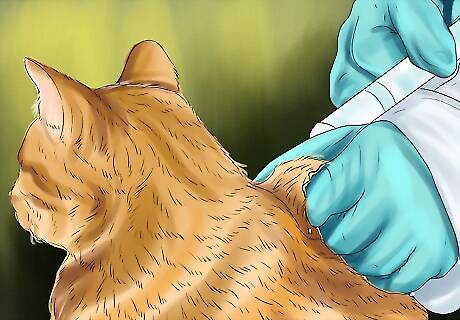
Schedule regular vet check-ups. After your cat’s initial visit and diagnosis, your vet will likely create a series of appointments to monitor your cat’s progress. During these visits your vet may draw blood to check on the condition of your cat and may question you about their recent behaviors. Be as honest as you can and try to make these appointments as scheduled to keep your cat’s treatment on track. For example, if the MAOI is intended to treat your cat’s aggression, your vet might ask, “Have you noticed any changes in your cat’s attitude?”
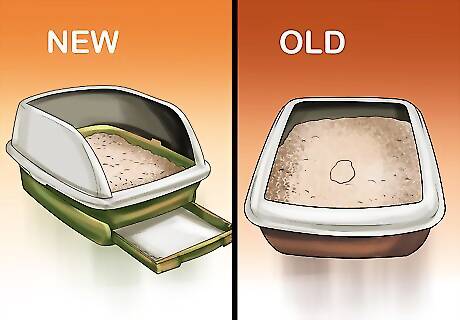
Continue with behavioral modifications. Even if the medication is successful, it’s a good idea to keep following the advice of the behaviorist. This will ensure that your cat’s progress stays intact and becomes a part of their life, not just a phase. For example, if you’ve made changes to your cat’s litter box during treatment, don’t immediately readjust it once you see some success.

Be patient. It may be frustrating to wait, but MAOIs take at least 2 weeks to effect behavior and can take even longer. Try to concentrate on behavioral modifications in the meantime. Don’t lash out at your cat, as this could set you back even further and destroy the trust that can help with treatment. Instead, if you get frustrated, ask your family members or friends to help you with caring for your cat for a day or 2.
Giving Your Cat a Pill

Cut or crush it. If the pills are larger and hard to hide, you can place the pill on a plate and try to break it into pieces with a butter knife. Or, you can purchase a pill breaker at a pharmacy and use it. You can also crush the pill into a fine dust by placing it between 2 spoons and applying pressure. Just make sure to keep track of the various pieces. For that reason, it is a good idea to use the medication immediately after crushing or cutting. Before you alter the pill’s form, make sure that the label says that it is okay to do so. Some medications can become less effective when crushed or cut.

Hide it within food. Add the medication directly to wet cat food and mix it in a bit to disguise the taste. Or, place pieces of the pill within a variety of soft treats, which you can then feed directly to your cat. You can also place the pill powder in chicken broth or another light liquid that your cat enjoys. Just avoid mixing the pill with milk, as it can lessen the effectiveness. It is best if the treats that you use are strong in flavor and malleable enough so that you can cover the entire pill. You can also give the first treat with no medicine and then start with the medicine-mixed treats. Your cat will be more likely to eat the treats if the first 1 tastes “normal.”
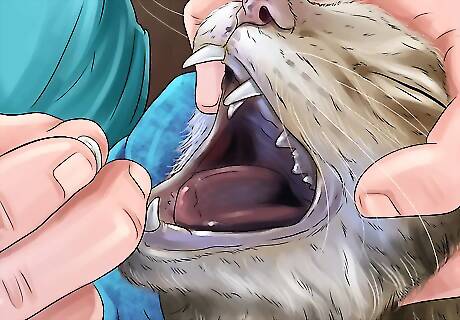
Hold open your cat’s mouth. If your cat is willing, you can grasp their upper and lower jaws and slowly spread them apart. Loosen one of your hands and drop the medicine all the way toward the back of their throat. Then, hold their jaw shut for a moment to allow them to swallow. You can also use a pill gun to make the process go quicker. Don’t attempt this method if you think your cat may bite you. Also, make sure that the pill is small or you could risk choking your cat.

Try a non-pill option. If you are uncomfortable or concerned about giving your cat a pill, then talk with your vet about alternate medication options. You can opt to use a dropper or syringe to insert liquid medication directly into your cat’s mouth. Going the liquid route may require switching brands, but it could be worth it in the long run if you can successfully give your cat the prescribed amount of medication.
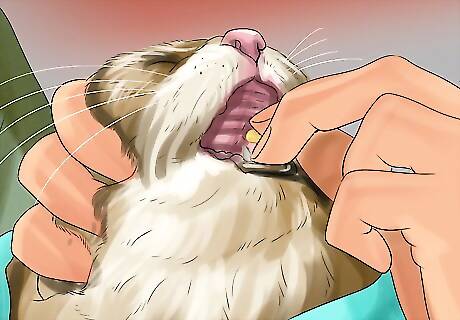
Practice giving the meds. As soon as you get the medication from the vet, begin the process of giving your cat the pill or liquid. Don’t wait a few days or delay at all. This is because you may need some practice before you are able to get your cat to eat the entire dosage each time. It may help to give your cat some affection after each session as encouragement for the future.













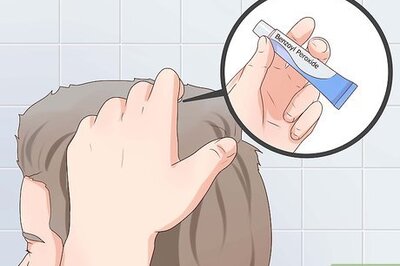




Comments
0 comment